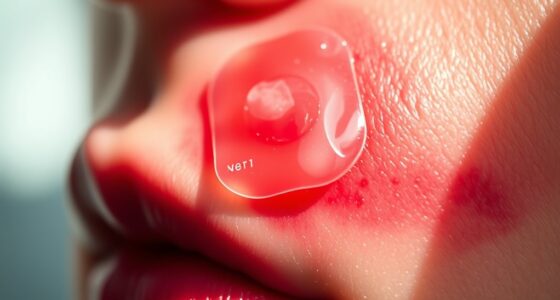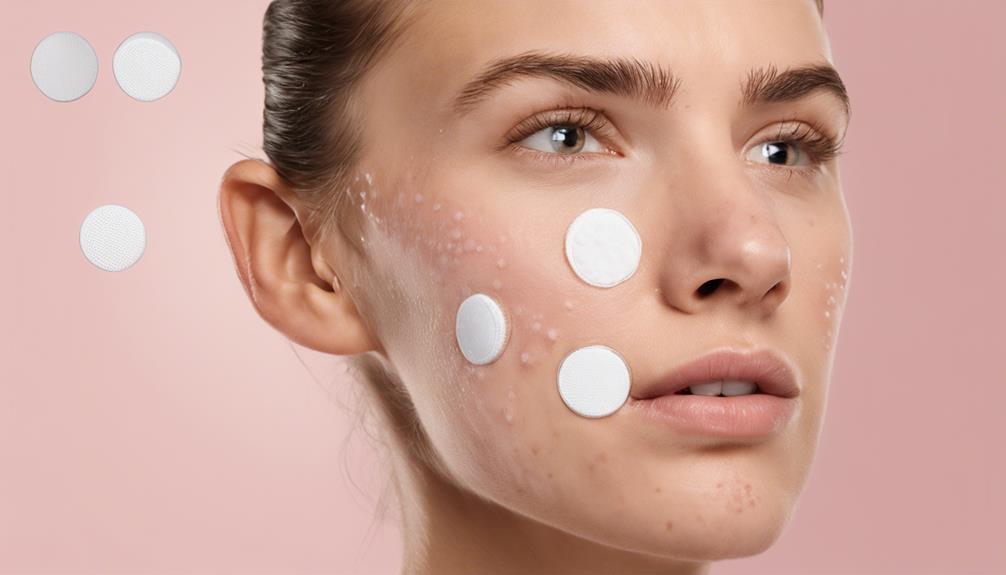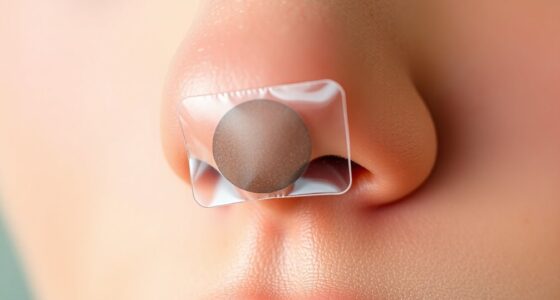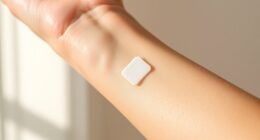Pimple patches can be a quick fix for minor blemishes, but they come with side effects you need to watch for. Skin irritation, like redness and peeling, is common, especially for sensitive skin. Allergic reactions to materials in the patches can cause dryness and swelling. Plus, they may not work on deeper acne types. Monitoring your skin for unusual reactions is essential. Stay informed about alternatives that can better support your skincare journey and overall skin health.
Key Takeaways
- Skin irritation, including redness and peeling, may occur, especially for individuals with sensitive skin following prolonged use of pimple patches.
- Allergic reactions to materials like latex and acrylates can cause dryness, swelling, and require immediate discontinuation and medical attention.
- Pimple patches are ineffective for deeper acne forms, such as cystic acne, and may worsen skin conditions if over-relied upon.
- Prolonged use can lead to moisture retention, trapping bacteria and sebum, potentially worsening breakouts.
- Monitor for signs of infection, such as increased redness or swelling, and seek professional help if symptoms persist or worsen.
Understanding Pimple Patch Side Effects
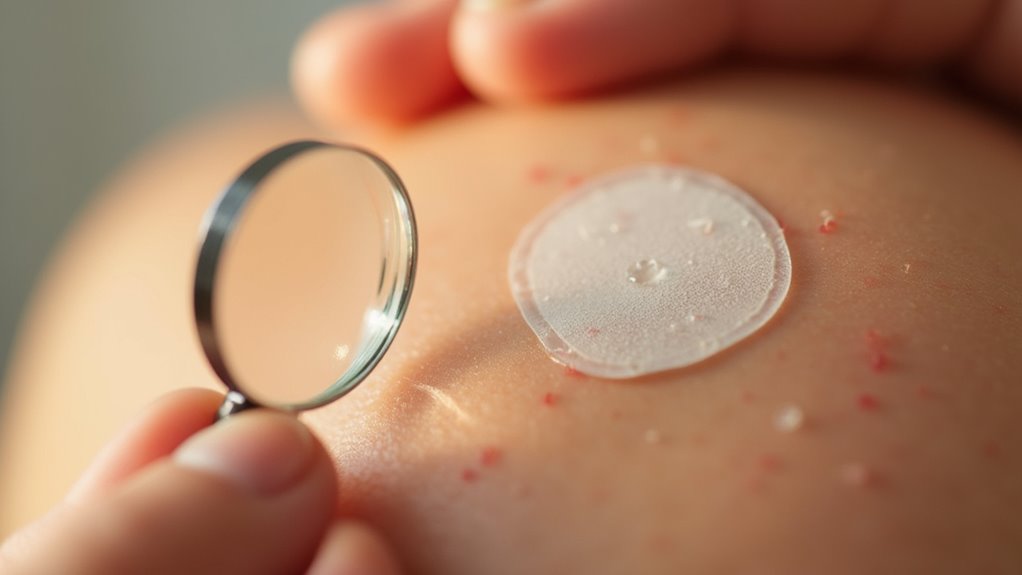
When using pimple patches, it’s important to be aware of potential side effects that can arise.
Pimple patches might lead to skin irritation, especially if you have sensitive skin. You could experience redness, itching, or even peeling due to their adhesive properties.
Additionally, allergic reactions to materials like latex or acrylates can occur, resulting in dryness or an unpleasant odor. Some users notice increased redness or swelling after application, signaling an adverse reaction or potential infection.
Allergic reactions to pimple patches can lead to dryness, unpleasant odors, and increased redness or swelling, indicating potential infection.
Furthermore, these patches may occlude pores, trapping bacteria and sebum, which might aggravate existing acne or create new lesions.
To minimize risks, conduct a patch test before full application, particularly if you know you have sensitivities.
Common Symptoms of Irritation
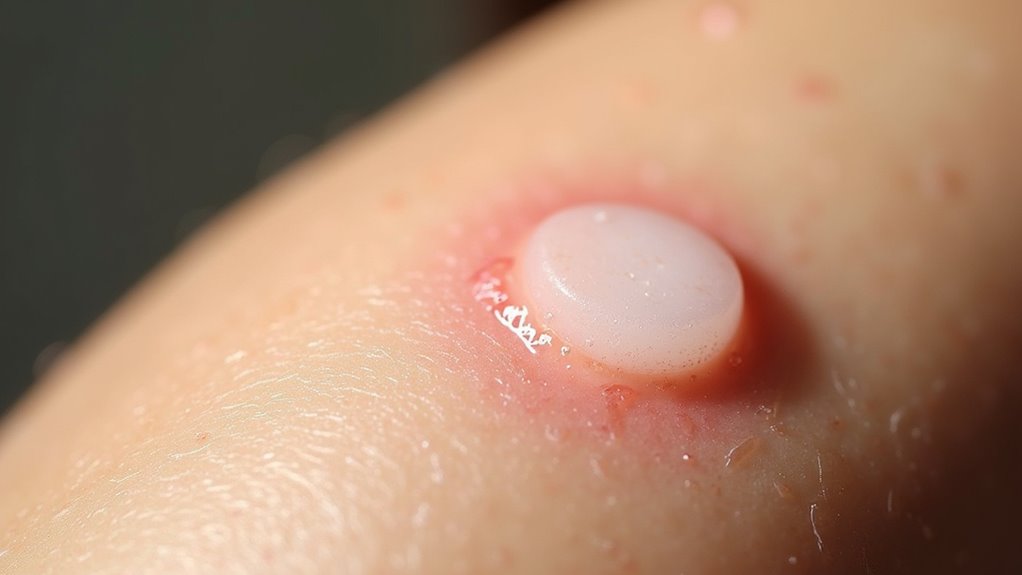
When using pimple patches, you might notice some common symptoms of irritation.
Redness around the patch is often due to the adhesive or active ingredients, while itching and peeling skin can indicate an allergic reaction. If these symptoms occur, it’s important to assess your skin’s reaction and consider discontinuing use. Additionally, some patches contain active ingredients like salicylic acid that may exacerbate irritation in sensitive skin types.
Redness Around Patch
Redness around the patch often signals irritation, indicating that your skin may be reacting to the adhesive or ingredients in the product. This redness can occur shortly after application or after prolonged wear. If you notice persistent redness or worsening symptoms, it may be time for a medical evaluation to prevent further damage. Individuals with sensitive skin should always perform a patch test before using pimple patches to minimize the risk of irritation. If redness is accompanied by itching or peeling, it may suggest an allergic reaction, prompting you to discontinue use immediately.
| Symptom | Possible Cause | Recommended Action |
|---|---|---|
| Redness | Adhesive irritation | Discontinue use |
| Itching | Allergic reaction | Seek medical advice |
| Persistent redness | Severe irritation | Medical evaluation |
| Mild redness | Normal response | Monitor symptoms |
Itching and Peeling Skin
Itching and peeling skin can be frustrating side effects that occur after using pimple patches, especially if you have sensitive skin. The adhesives in these patches may trigger irritation or even allergic reactions, resulting in redness, itching, and peeling skin.
If you find yourself experiencing these symptoms after applying a pimple patch, it’s best to stop using it and consult a healthcare provider to evaluate any potential allergic reactions. The severity of irritation can vary based on your skin type and sensitivities.
To minimize the risk of issues, always perform a patch test on a small area before applying pimple patches more broadly. This precaution can help you avoid unwanted discomfort and guarantee your skin stays healthy.
Allergic Reactions to Pimple Patches
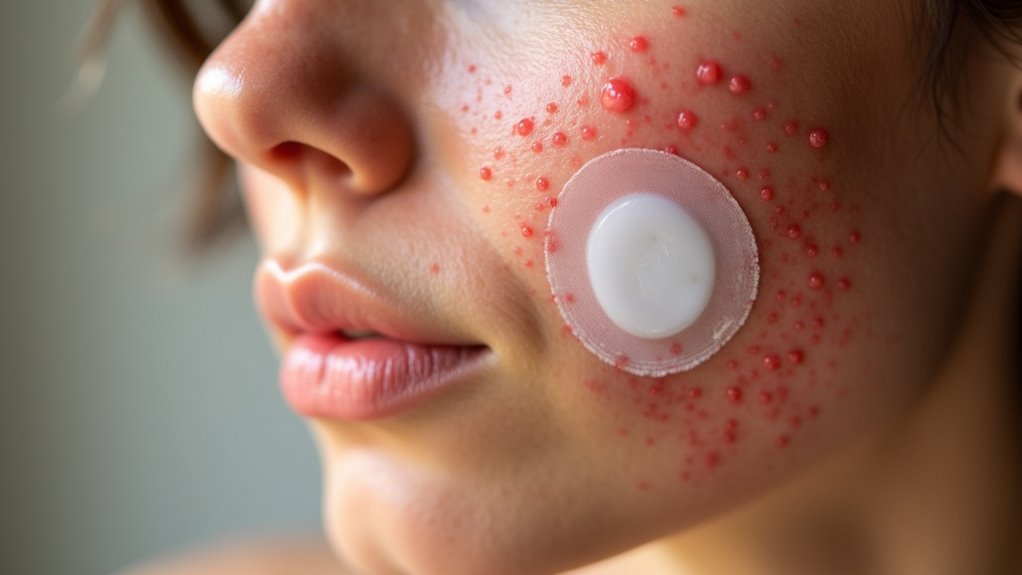
If you’re using pimple patches for their convenience, be aware that they can trigger allergic reactions in sensitive individuals.
Symptoms like redness, itching, and peeling around the patch area might indicate skin irritation. Common allergens in pimple patches include latex, colophony, and acrylates, so it’s essential to know your sensitivities.
If you suspect you may be allergic, consider patch tests before widespread use. While serious allergic reactions are rare, they can occur and may require immediate medical attention if you experience swelling or severe discomfort.
Consider patch testing to identify potential allergies before using pimple patches widely, as serious reactions, though rare, can occur.
If you notice any adverse reactions after applying a patch, discontinue use and consult your healthcare provider for guidance. Staying informed can help you avoid unwanted complications.
Risks for Sensitive Skin Types
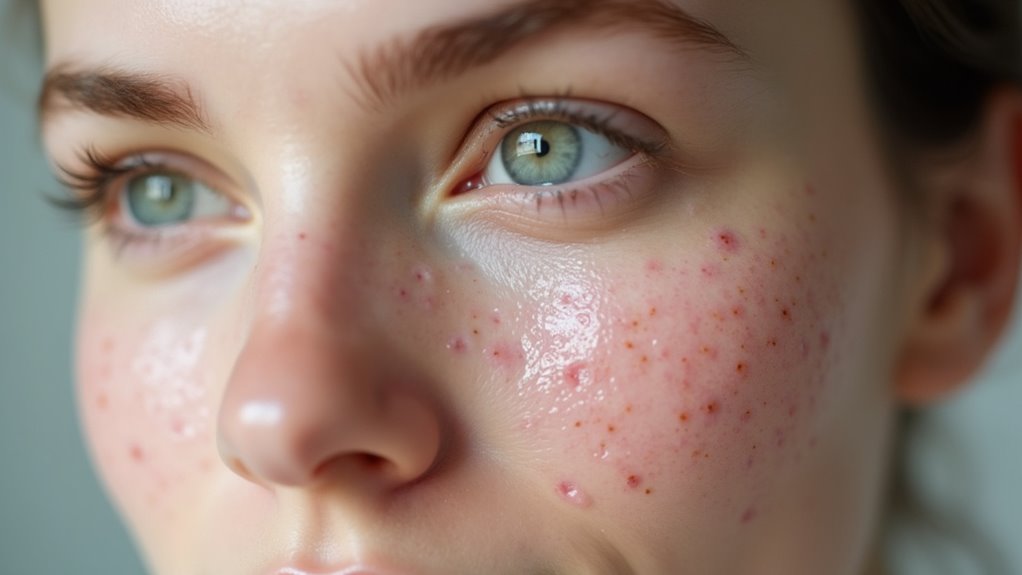
For those with sensitive skin, the risks associated with using pimple patches can be significant, as the adhesives and active ingredients may provoke irritation.
Ingredients like salicylic acid and tea tree oil, common in these patches, can trigger allergic reactions, leading to dryness, redness, or bad odors.
If you have known sensitivities, conducting patch tests is vital to identify potential reactions before applying the product fully.
Increased irritation or inflammation can worsen existing skin conditions if pimple patches aren’t used properly.
It’s important to consult a dermatologist before using pimple patches to guarantee you choose safe and effective acne treatment options tailored to your sensitive skin. Additionally, understanding the potential side effects of the active ingredients can help in making informed choices.
Acne Patch Limitations

While pimple patches can be handy for surface-level acne, they fall short when it comes to deeper cystic acne.
You might also find that these patches can irritate sensitive skin, leading to unwanted reactions.
Relying too much on them won’t address the underlying causes of your breakouts, so it’s essential to contemplate a broader skincare approach.
Ineffective for Deep Acne
Although pimple patches can be a handy solution for surface-level acne, they fall short when it comes to treating deeper forms like cystic acne. Cystic acne involves painful nodules beneath the skin that pimple patches can’t penetrate. While they might reduce surface redness temporarily, they won’t address the underlying inflammation or root causes, which can actually delay healing.
| Pimple Patch Use | Cystic Acne Impact |
|---|---|
| Ineffective for deep acne | Traps moisture & bacteria |
| Reduces surface redness | Can increase inflammation |
| Not a substitute for a skincare regimen | Requires professional dermatological intervention |
For effective treatment, a thorough skincare regimen and professional help are essential. Relying solely on patches could worsen your condition.
Potential Skin Irritation
Using pimple patches might seem like a quick fix, but they can lead to potential skin irritation for some users.
If you have sensitive skin or existing conditions like eczema, be cautious. You might experience:
- Redness and itching after application
- Peeling or dryness around the patch
- Allergic reactions to common allergens like latex or acrylates
- Adverse reactions that could worsen over time
If you notice any irritation or discomfort, it’s important to discontinue use immediately.
Persistent symptoms should prompt a consultation with your healthcare provider to guarantee you address any underlying issues.
Potential for Skin Damage
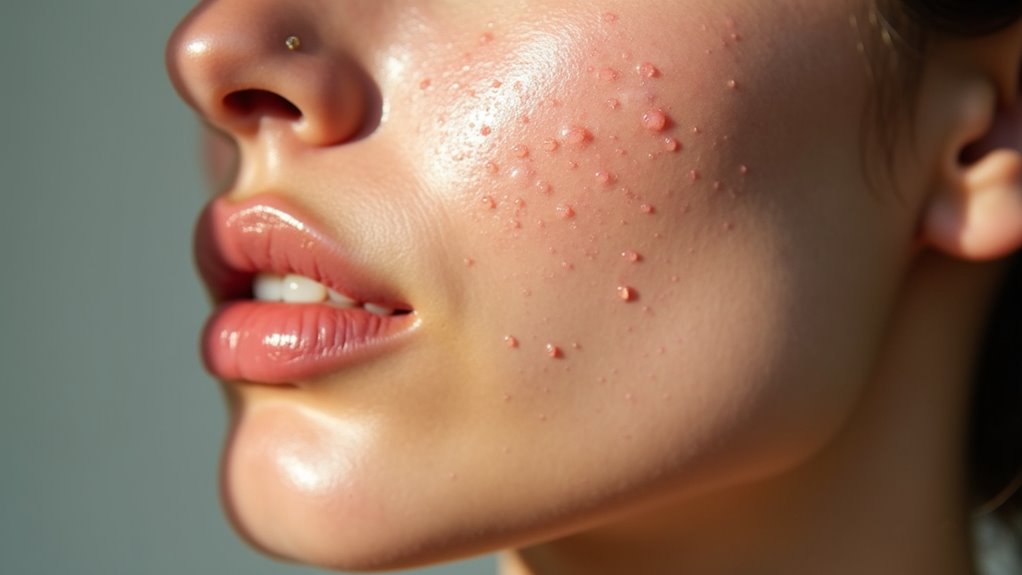
Pimple patches can be a double-edged sword when it comes to treating acne, as they may lead to skin damage if not used carefully. While they offer benefits, prolonged use of pimple patches can cause skin irritation, including redness and peeling, especially for sensitive skin.
The adhesive materials may trigger allergic reactions, requiring immediate medical attention. Additionally, moisture retention from these patches can inhibit airflow, delaying the healing process of cystic acne. This occlusion can trap bacteria and sebum, worsening your breakouts.
After removing the patches, if you notice red marks or increased irritation, it may indicate skin damage. In such cases, it’s wise to discontinue use and consult a healthcare provider for guidance.
Misconceptions About Quick Fixes
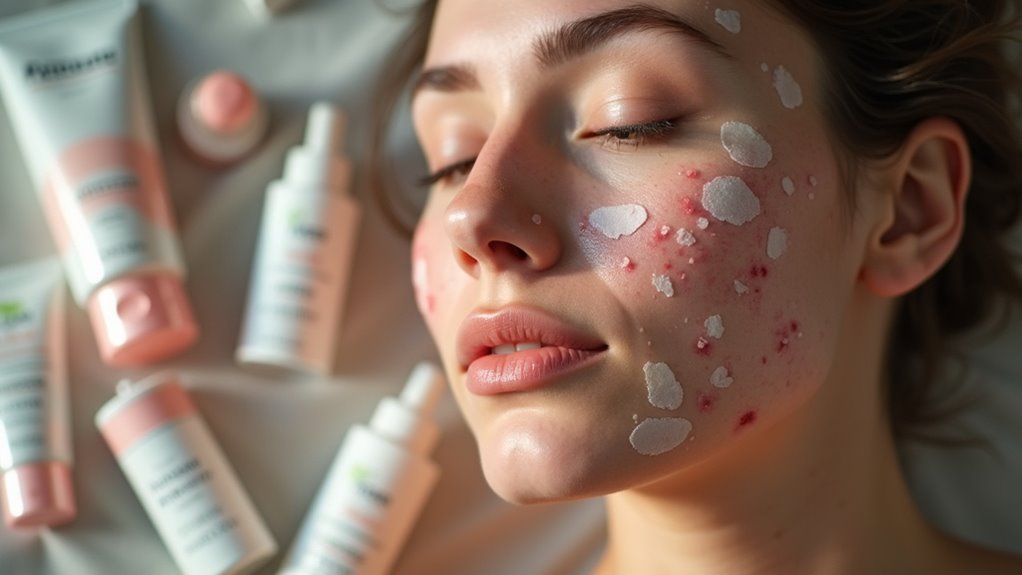
You might think pimple patches are a one-size-fits-all solution for acne, but they really only work well on surface-level breakouts.
Relying on them can lead you to overlook the importance of a complete skincare routine that addresses deeper issues.
Surface-Level Solutions Only
While many people reach for pimple patches as a quick fix for acne, these products often provide only surface-level solutions. They primarily target whiteheads and minor blemishes, leaving deeper cystic acne unaddressed.
Here are some misconceptions about pimple patches:
- They can solve all types of acne.
- They replace an all-encompassing treatment plan.
- They prevent future breakouts.
- They eliminate the need for a skincare routine.
Overreliance on pimple patches can lead you to neglect essential skincare practices that tackle underlying causes of acne. Incorporating antioxidant-rich foods into your diet can support skin health and reduce inflammation.
While they may offer quick relief for visible pimples, without a holistic approach, you’re likely to see only temporary results and persistent issues down the line.
Neglecting Comprehensive Care
Many people mistakenly think that pimple patches are a complete solution for acne, leading to a dangerous neglect of thorough care.
While they offer temporary relief for surface-level blemishes, they don’t address underlying causes like hormonal imbalances or clogged pores.
Relying solely on pimple patches can cause you to overlook necessary treatments for deeper acne, which may require professional intervention.
An effective acne management strategy involves an extensive care approach, including a consistent skincare routine, topical medications, and lifestyle adjustments.
Thinking pimple patches can replace these essential elements can worsen your skin condition.
Importance of Monitoring Skin Reactions

Monitoring skin reactions is essential when using pimple patches, especially since they can irritate sensitive skin.
Regularly checking your skin can help you notice any adverse reactions early on, allowing for quick action if needed.
- Look for redness, itching, or peeling, which indicates irritation.
- Be aware of any dryness, rashes, or unusual odors that could signal allergic reactions.
- Perform patch testing if you have known sensitivities to identify potential issues before applying the patch widely.
- Keep an eye out for signs of infection, like increasing redness or swelling, that may require medical attention.
When to Seek Professional Help
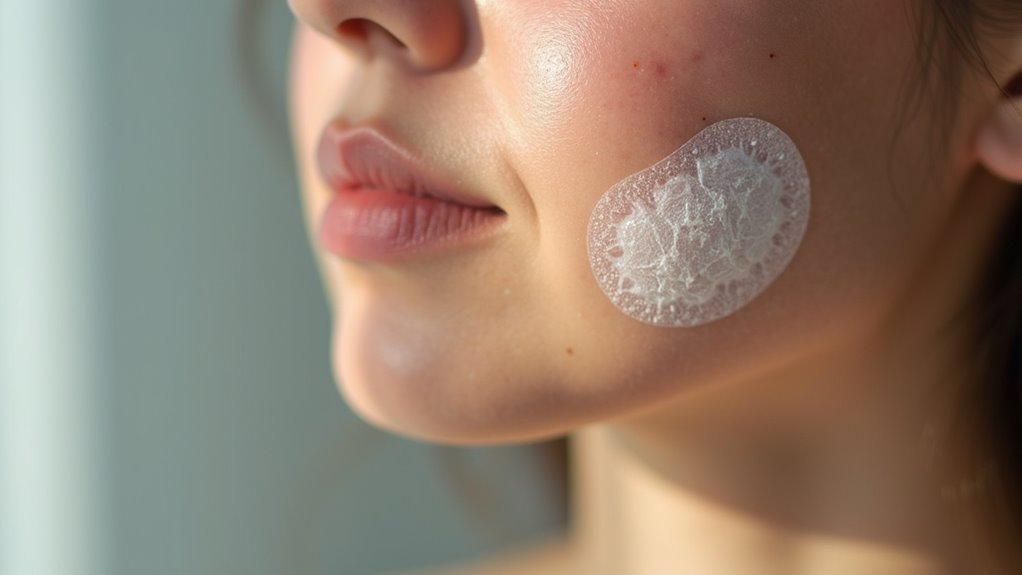
When should you consider seeking professional help after using pimple patches? If you notice persistent redness, swelling, or pain around the area, it could indicate an infection or an adverse reaction. Worsening acne or new breakouts following pimple patch use also warrants medical attention. Individuals with sensitive skin or known allergies should consult a dermatologist before use, especially if irritation occurs. Consistent red marks or peeling after patch removal signal the need for dermatological advice.
| Symptoms to Watch For | Action to Take |
|---|---|
| Persistent irritation | Seek medical help |
| New or worsening acne | Consult a dermatologist |
| Red marks or peeling | Stop use and evaluate |
Don’t hesitate to seek professional help for any concerning skin conditions.
Alternatives to Pimple Patches
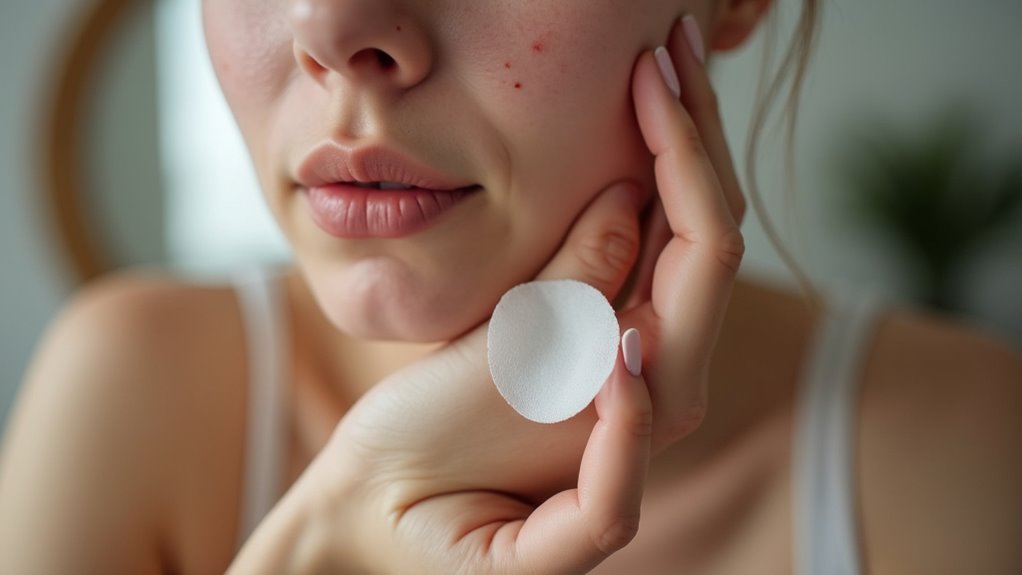
If you’re looking for alternatives to pimple patches, several effective options can help you manage acne more effectively. Consider these alternatives:
- Topical acne treatments: Products containing benzoyl peroxide or salicylic acid can target the root causes of acne vulgaris directly.
- Over-the-counter retinoids: Medications like adapalene unclog pores and prevent future breakouts, but consistency is key.
- Hormonal therapies: Birth control pills and spironolactone help regulate hormonal fluctuations, making them effective for hormonal acne.
- Good skincare practices: Using gentle cleansers and non-comedogenic products can enhance overall skin health and reduce pimples.
In addition to these options, maintaining a balanced diet with whole, unprocessed foods can also contribute to better skin health.
While pimple patches can be convenient, exploring these options might provide more all-encompassing solutions for your acne concerns.
Frequently Asked Questions
What Are the Negative Effects of Pimple Patch?
Pimple patches can have some negative effects you should be aware of.
You might experience skin irritation, such as redness or itching, especially if your skin is sensitive. Allergic reactions to the adhesive could range from mild dryness to severe issues needing medical attention.
Using patches on open wounds can trap moisture and bacteria, worsening acne instead of helping.
After removal, you might notice increased redness or swelling, indicating a potential adverse reaction.
When Should I Stop Using Pimple Patches?
Did you know that about 30% of people experience skin irritation from using pimple patches?
If you’re seeing increased redness, swelling, or pain, it’s time to stop using them. Persistent itching or peeling around the area is another red flag.
Avoid applying patches on open wounds or skin rashes. If they’re not working for you after several tries, consider exploring other treatment options or consult a dermatologist for tailored advice.
What Happens if You Leave a Pimple Patch on Too Long?
If you leave a pimple patch on too long, you might experience skin irritation like redness, itching, or peeling around the area.
The patch can become overly saturated, which reduces its effectiveness in absorbing fluids.
Additionally, prolonged wear can create a moist environment that traps bacteria, potentially leading to more inflammation or new breakouts.
It’s best to stick to the recommended duration of 6 to 8 hours to avoid these issues.
Do Dermatologists Recommend Pimple Patches?
Yes, dermatologists often recommend pimple patches as a helpful tool for treating surface-level acne, especially whiteheads.
They appreciate how these patches absorb excess fluid and provide a protective barrier over blemishes.
However, they emphasize that pimple patches aren’t a substitute for professional treatment and should be part of a broader skincare routine.
If you have sensitive skin, it’s wise to patch test first to prevent any irritation or allergic reactions.
Conclusion
In the world of skincare, pimple patches can be a double-edged sword. While they offer quick relief, they can also lead to unwanted side effects. Keep an eye on your skin’s reactions, and don’t hesitate to seek professional advice if irritation arises. Remember, just like a gardener tending to delicate flowers, your skin deserves careful attention and care. Explore alternatives if patches aren’t for you, and nurture your skin with love for the best results.
Claire has a knack for turning complex dermatological concepts into engaging, easy-to-understand articles. Her work primarily focuses on creating detailed reviews and thought-provoking articles in the “Vetted” category. Claire’s writing not only informs but also inspires our community to try new skincare solutions.




